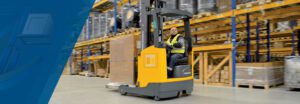
10 Ways to Improve Fleet Utilization
Improving equipment utilization and productivity in a warehouse setting is essential for optimizing operations and minimizing costs. Here are several effective solutions to enhance both:
Effectively managing maintenance and minimizing downtime in a warehouse is crucial for ensuring operational efficiency and productivity. Here are some solutions to help address these challenges:
1. Implement a Preventive Maintenance Program
Implementing a regular preventive maintenance schedule is essential for optimizing the performance and longevity of all material handling equipment. By performing routine inspections, servicing, and essential adjustments, you can keep equipment like forklifts, conveyors, and pallet jacks in peak working condition. This proactive approach involves checking for wear and tear, lubricating moving parts, replacing filters, and tightening any loose bolts or connections to prevent larger, costly repairs.
Preventive maintenance minimizes the risk of sudden equipment failures, as potential issues are detected early and addressed before they escalate into major problems. This not only reduces unplanned downtime, which can disrupt operations, but also enhances safety by ensuring that machinery is functioning correctly and safely. Furthermore, a well-maintained fleet contributes to lower operating costs by improving fuel efficiency and reducing the likelihood of extensive repairs.
2. Implement a CMMS
A Computerized Maintenance Management System (CMMS) is a powerful tool for organizing and streamlining maintenance operations across a facility. By tracking maintenance schedules, managing work orders, and maintaining detailed equipment records, a CMMS centralizes essential information in one easy-to-access platform. This software enables warehouse managers to plan, prioritize, and automate maintenance tasks with minimal manual intervention, ensuring that preventive and corrective maintenance is scheduled and executed on time.
Through a CMMS, warehouse managers can monitor equipment health and performance trends, allowing for data-driven decisions on repair or replacement. The software can send automated reminders for upcoming inspections and maintenance, reducing the risk of missed servicing that could lead to unexpected breakdowns. Additionally, it allows for the creation and tracking of work orders, helping ensure that tasks are assigned to the appropriate technicians and completed efficiently. Comprehensive records in a CMMS provide insights into each piece of equipment’s service history, helping managers evaluate the total cost of ownership and plan for future investments. This digital tool is invaluable for enhancing equipment reliability, extending asset life, and ultimately lowering overall maintenance costs.
3. Train Staff on Basic Maintenance
Training operators on basic maintenance tasks is a strategic investment that pays off by fostering a proactive approach to equipment care and upkeep. When operators are equipped to perform daily inspections, identify early signs of wear, and handle minor repairs, they become the first line of defense against equipment breakdowns. Basic maintenance knowledge empowers operators to spot issues such as fluid leaks, worn tires, unusual noises, or loose parts, allowing them to address or report these problems promptly before they escalate.
This training reduces the dependency on specialized maintenance personnel for minor issues, freeing up technicians to focus on more complex repairs and preventive maintenance. By enabling operators to handle these small tasks independently, the facility can experience increased uptime and smoother workflow continuity. Additionally, regular hands-on interaction with equipment enhances operators’ familiarity with its functions and performance, making them more adept at recognizing subtle changes in machine behavior that could indicate emerging issues.
Beyond reducing unplanned downtime and repair costs, operator training promotes a culture of responsibility and ownership in equipment care. This proactive maintenance culture not only extends the lifespan of assets but also improves workplace safety, as operators are more likely to address potential hazards. Ultimately, well-trained operators contribute to a safer, more efficient, and cost-effective facility, benefiting both the organization and the workforce.
4. Monitor Equipment Performance with IoT Sensors
Integrating Internet of Things (IoT) sensors into material handling equipment revolutionizes maintenance strategies by providing continuous, real-time monitoring of essential performance metrics. These sensors can track factors such as temperature, vibration, usage hours, fluid levels, and wear patterns, allowing managers to keep a pulse on equipment health around the clock. With IoT-enabled data, managers can gain visibility into equipment conditions that would otherwise be challenging to detect, such as overheating, unusual vibration patterns, or declining battery efficiency.
This real-time data can be programmed to trigger alerts if performance metrics deviate from optimal ranges, providing early warnings of potential issues before they lead to costly breakdowns. For instance, an abnormal increase in operating temperature could signal a mechanical issue or lubrication need, while elevated vibration levels might indicate worn bearings. With immediate access to this data, managers can plan maintenance based on actual equipment conditions rather than estimated schedules, making it easier to schedule repairs at the right time to avoid disruptions.
The insights from IoT data not only improve proactive maintenance planning but also support predictive maintenance, where patterns over time can forecast when specific components are likely to need attention. This predictive approach enables better inventory management by identifying which parts to keep on hand, reducing downtime caused by waiting for replacements. Moreover, IoT data can be integrated with a CMMS, allowing automatic creation of maintenance orders or adjustments to maintenance schedules based on real-time usage data. By enabling data-driven maintenance, IoT sensors contribute to longer equipment lifespan, reduced operational costs, and optimized productivity, helping companies maintain a competitive edge in their logistics and warehouse operations.
5. Develop a Spare Parts Inventory
Keeping a well-organized inventory of critical spare parts is essential for minimizing downtime and ensuring seamless repair processes. When essential components like filters, belts, bearings, or electronic sensors are readily available, maintenance teams can promptly address equipment issues without delays caused by sourcing or waiting for parts to arrive. This readiness is particularly crucial for equipment that performs vital, high-frequency tasks, where even short downtimes can create significant bottlenecks in workflows.
An optimized spare parts inventory helps avoid costly disruptions by ensuring that the parts needed for the most common repairs are on hand, allowing for faster turnaround times when repairs are necessary. By categorizing spare parts based on usage frequency and criticality to operations, managers can prioritize stocking components that are most likely to cause extended downtime if unavailable. Additionally, maintaining an accurate and up-to-date inventory can prevent overstocking or understocking, which balances costs while maintaining operational readiness.
Moreover, pairing a spare parts inventory with a CMMS or similar tracking system can streamline restocking and help forecast future needs based on maintenance records. This enables a proactive approach, where managers can spot trends and reorder items before inventory runs low, avoiding emergency purchases that may come with increased costs. With a reliable supply of critical components, facilities can achieve greater equipment reliability, extend asset life, and sustain consistent productivity levels—ultimately protecting profitability and maintaining smooth, uninterrupted operations.
6. Conduct Root Cause Analysis
Conducting a root cause analysis (RCA) after an equipment failure is a vital step in building a resilient maintenance strategy. By examining the circumstances, environmental factors, and usage patterns leading up to a breakdown, maintenance teams can identify not only the immediate cause but also any deeper, underlying issues that may have contributed to the failure. This process involves systematically investigating potential factors, such as improper operation, mechanical wear, insufficient lubrication, or environmental conditions, to pinpoint the true origin of the problem.
Through RCA, teams can distinguish between isolated incidents and recurring issues, allowing them to tailor maintenance practices to address systemic vulnerabilities. For instance, if a root cause analysis reveals that a specific part consistently fails due to excessive vibration, maintenance can focus on improving vibration control, enhancing operator training, or even adjusting the operational settings of the equipment. Identifying these underlying factors enables a shift from reactive to proactive maintenance, where improvements are made to prevent similar failures in the future.
Additionally, RCA helps build a knowledge base that can be shared across maintenance teams, enabling continuous improvement of maintenance protocols. By recording root causes and the actions taken to resolve them, teams create a reference for troubleshooting similar issues, saving time and resources on future repairs. This analytical approach not only reduces the likelihood of repeat failures but also supports data-driven decision-making, optimizing maintenance schedules, part replacements, and training needs. Ultimately, root cause analysis strengthens asset reliability, enhances operational efficiency, and contributes to a safer, more productive working environment.
By implementing these solutions, warehouse managers can significantly reduce maintenance-related downtime, ensuring that material handling equipment operates efficiently and effectively, ultimately enhancing overall productivity. Need help? Contact Us!

Improving equipment utilization and productivity in a warehouse setting is essential for optimizing operations and minimizing costs. Here are several effective solutions to enhance both:

Flexibility is critical for businesses and renting forklifts can be a surprisingly easy way to cut costs on a short-term basis. However, to maximize the
732.220.0444
1471 Jersey Avenue
North Brunswick, NJ 08902